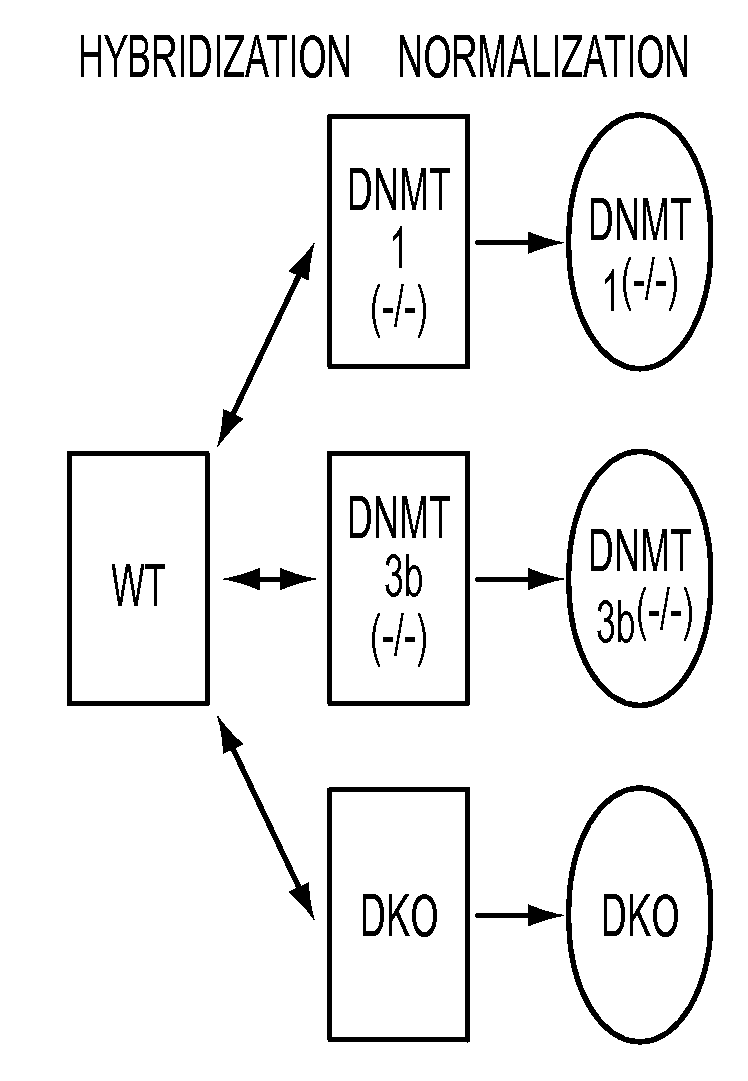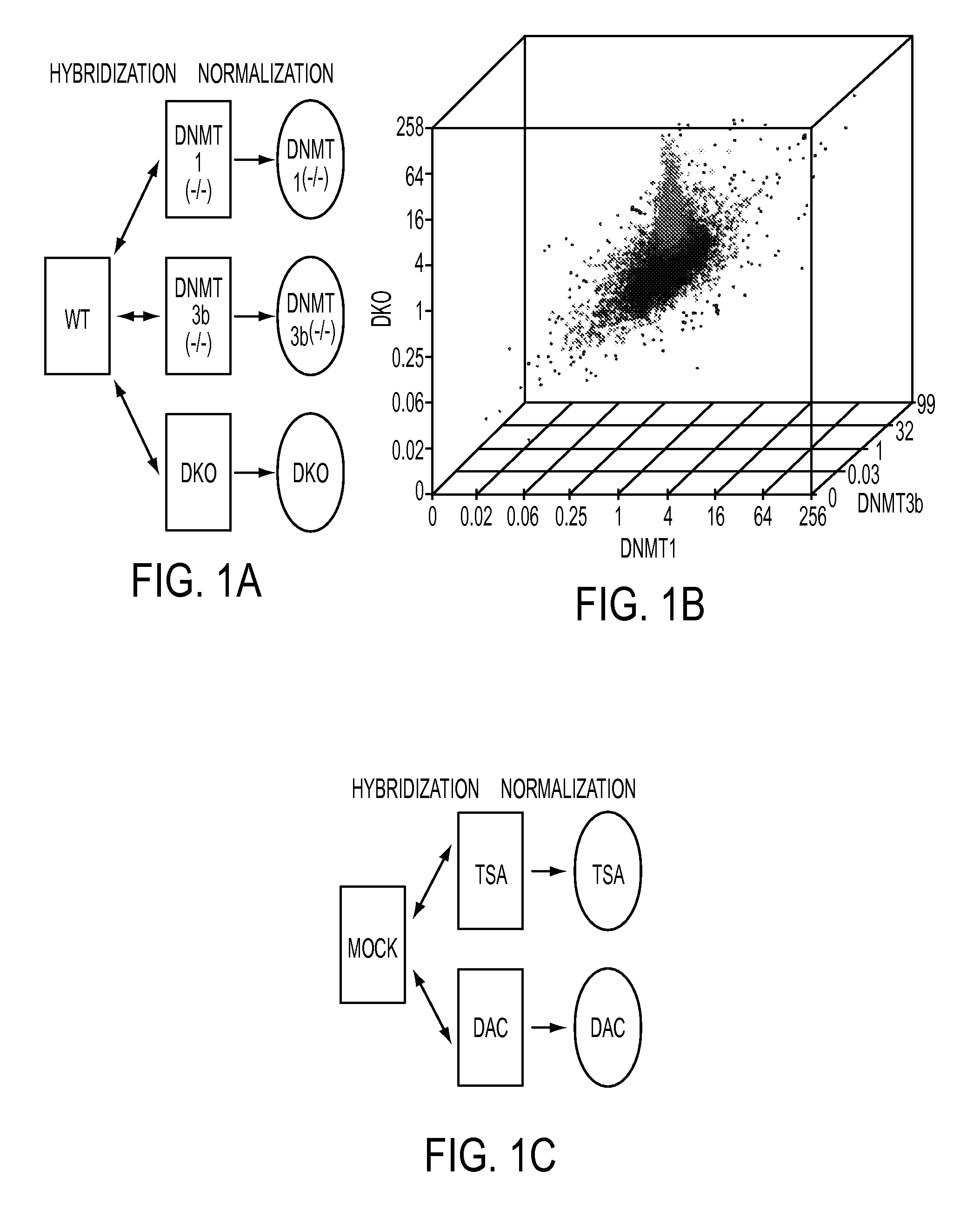Early Detection and Prognosis of Colon Cancers
a colon cancer and early detection technology, applied in the field of cancer diagnostics and therapeutics, can solve the problems of loss of expression of genes critical for maintaining a healthy state, and achieve the effects of reducing or inhibiting neoplastic growth
- Summary
- Abstract
- Description
- Claims
- Application Information
AI Technical Summary
Problems solved by technology
Method used
Image
Examples
example 1
Materials and Methods
[0088]Cell culture and treatment. HCT116 cells and isogenic genetic knockout derivatives were maintained as previously described (14). For drug treatments, log phase CRC cells were cultured in McCoys 5A media (Invitrogen) containing 10% BCS and 1× penicillin / streptomycin with 5 μM 5aza-deoxycytidine (DAC) (Sigma; stock solution: 1 mM in PBS) for 96 hours, replacing media and DAC every 24 hours. Cell treatment with 300 nM Trichostatin A (Sigma; stock solution: 1.5 mM dissolved in ethanol) was performed for 18 hours. Control cells underwent mock treatment in parallel with addition of equal volume of PBS or ethanol without drugs.
[0089]Microarray analysis. Total RNA was harvested from log phase cells using Triazol (Invitrogen) and the RNeasy kit (Qiagen) according to the manufacturers instructions, including a DNAase digestion step. RNA was quantified using the Nanoprop ND-100 followed by quality assessment with 2100 Bioanalyzer (Agilent Technologies). RNA concentra...
example 2
[0093]Our first step towards a global identification of hypermethylation dependent gene expression changes was made by comparing, in a genome wide expression array-based approach, wild type HCT116 CRC cells with isogenic partner cells carrying individual and combinatorial genetic deletions of two major human DNA methyltransferases (FIG. 1A, 14). Importantly, in the DNMT1(− / −)DNMT3b(− / −) double knockout (DKO) HCT116 cells, which have virtually complete loss of global 5-methylcytosine, all previously individually examined hypermethylated genes lacking basal expression in wild type cells undergo promoter demethylation with concomitant gene re-expression (14-17). By stratifying genes according to altered signal intensity on a 44K Agilent Technologies array platform, we observe a unique spike of gene expression increases in the DKO cells when compared to the isogenic wildtype parental cells, or isogenic cell lines in which DNMT's 1 or 3b have been individually deleted and which harbor mi...
example 3
[0095]To address the sensitivity with which our new array approach identifies CpG island hypermethylated genes, we first examined 11 genes known to be hypermethylated, completely silenced and re-expressed after DAC treatment in HCT116 cells (FIG. 4 (S1A)) (14-17). All tested genes remained within the TSA non-responsive zone (FIG. 4 (S1B and C)), and the direction of expression changes correlated well in DAC treated and DKO cells (FIG. 4 (S1D)). Importantly, for the DAC increase, 5 of the guide genes (45%) increased 2-fold or more and 3 more genes, or a total of 73%, increased 1.3 fold or more.
[0096]Based on the sensitivity differences observed between DKO and DAC induced gene increases, and behavior of the guide genes in the array platform, we designated, within the TSA negative zone, a top tier (2 fold increase or above) and a next tier of genes (increasing between 1.4 and 2 fold) to identify hypermethylated cancer genes (FIG. 2B). We also picked genes from these zones based on the...
PUM
| Property | Measurement | Unit |
|---|---|---|
| concentrations | aaaaa | aaaaa |
| total volume | aaaaa | aaaaa |
| total volume | aaaaa | aaaaa |
Abstract
Description
Claims
Application Information
 Login to View More
Login to View More - R&D
- Intellectual Property
- Life Sciences
- Materials
- Tech Scout
- Unparalleled Data Quality
- Higher Quality Content
- 60% Fewer Hallucinations
Browse by: Latest US Patents, China's latest patents, Technical Efficacy Thesaurus, Application Domain, Technology Topic, Popular Technical Reports.
© 2025 PatSnap. All rights reserved.Legal|Privacy policy|Modern Slavery Act Transparency Statement|Sitemap|About US| Contact US: help@patsnap.com



